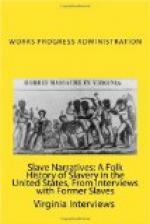Support
“I used to get a little money from Mr. Dent long as he was living. I would go over there and he would give me a dollar or two. Since he’s been dead, his wife don’t have much to give me. She gives me something to eat sometimes but she doesn’t have any money now that her husband is dead.
“I can’t get up to the Welfare. Crippled as I am, I can’t walk up and down those stairs, and I can’t git there nohow. I been tryin’ to git some one to take me up there.
“Mr. Pratt helps me from time to time, but he ain’t sent me nothin’ now in a good while. He’s right smart busy, but if I go to him, I spect he’ll stir up somethin’ for me.
Travels
“I wouldn’t never a left Bartow County, but the white people made out that this was a rich country and you could make so much out here, and we moved out here. We was young then. We came out on the train. It was a long time back but it was too far to came on a wagon. I don’t remember just how long ago it was.
Occupation
“I used to quilt until my fingers got too stiff. I got some patterns in there now if you want to see them.”
Interviewer’s Comment
The old lady took me in the house and showed me about a dozen quilts, beautifully patterned and made. She had also some unfinished tops. She says that she does not have much of a sale for them now because the “quality of folks” who liked such things well enough to buy them “is just about gone.”
She is crippled and unable to walk with facility. She has a great deal of difficulty in getting off and on her porch. Still she does not impress one as feeble so much as just disabled in one or two particulars. She has a crippled knee, and both of her hands are peculiarly stiff in the finger joints, one more so than the other. If it were not for the disabilities, as old as she is, I believe that she could give a good account of herself.
I didn’t have the heart to tell the old lady that her Bible record is not what she thinks it is. It is not the old original record which her mistress possessed. Neither is it the copy of the record of her mistress which her mother kept. From questioning, I gather that the old mistress dictated the original record to some one connected with her mother, might have written it out herself on a sheet of paper. From time to time, as new deaths and births occurred, scraps of paper containing them were added to the first paper, and as the papers got worn, blurred, and dog-eared, they were copied—probably not without errors. Time came when the grandchildren up in the grades and with semi-modern[HW:?] ideas copied the scraps into the family Bible. By that time aging and blurring of the original lead pencil notes, together with recopying, had invalidated the record till it is no longer altogether reliable.




